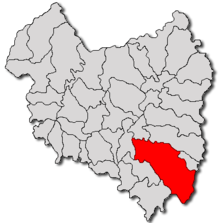Zagon
|
Zagon Zágon |
||||
|
||||
| Basic data | ||||
|---|---|---|---|---|
| State : |
|
|||
| Historical region : | Transylvania | |||
| Circle : | Covasna | |||
| Coordinates : | 45 ° 46 ' N , 26 ° 7' E | |||
| Time zone : | EET ( UTC +2) | |||
| Height : | 517 m | |||
| Area : | 66.00 km² | |||
| Residents : | 5,282 (October 20, 2011) | |||
| Population density : | 80 inhabitants per km² | |||
| Postal code : | 527185 | |||
| Telephone code : | (+40) 02 67 | |||
| License plate : | CV | |||
| Structure and administration (as of 2016) | ||||
| Community type : | local community | |||
| Structure : | Zagon, Păpăuți | |||
| Mayor : | Josif Kis ( UDMR ) | |||
| Postal address : | Str. Principală, no. 114 loc. Zagon, jud. Covasna, RO-527185 |
|||
| Website : | ||||
Zagon (outdated Zagun ; Hungarian Zágon ) is a municipality in the Covasna district , in the Transylvania region in Romania .
Geographical location
The municipality of Zagon is located east of the Kronstadt depression (Depresiunea Brașovului) , in the northwestern foothills of the Întorsura Mountains (Munții Întorsurii) - a part of the Eastern Carpathian Mountains . In the historical region of Szeklerland in the southeast of the Covasna district, Zagon is located on the stream of the same name and on Drum na Drumional 13E, about 13 kilometers south of the small town of Covasna (Kovasna) and about 30 kilometers southeast of the district capital Sfântu Gheorghe (Sankt Georgen) .
The nearest train station is in Boroșneu Mare (large wine village), ten kilometers away, on the Brașov – Sfântu Gheorghe – Târgu Secuiesc railway line .
history
The town of Zagon, mainly inhabited by Szeklern people, was first mentioned in a document in 1567. According to Orbán Balázs, urns were found on the area of the village, but could not yet be assigned to an era. Otherwise, numerous archaeological finds in the municipality point back from Roman times to the Late Bronze Age . According to information from Márton Roska from 1934, parts of the volcanic rock obsidian were also found near Zagon . Zagon's findings are in the museums of Aiud (Strasbourg am Mieresch) and Sfântu Gheorghe.
At the time of the Kingdom of Hungary Cernat belonged to the Orbai chair district in the Háromszék County ( Romanian Comitatul Trei-Scaune ), then to the historical Trei-Scaune district (German three chairs ) and from 1950 to the present Covasna district.
population
The population of the municipality of Zagon developed as follows:
| census | Ethnic composition | ||||
|---|---|---|---|---|---|
| year | population | Romanians | Hungary | German | other |
| 1850 | 4,636 | 755 | 3,764 | 24 | 93 |
| 1920 | 8,439 | 2,864 | 5,417 | 3 | 155 |
| 1941 | 5,790 | 1,087 | 4,408 | 2 | 293 |
| 2002 | 5,489 | 2,722 | 2,728 | - | 39 |
| 2011 | 5,282 | 2,515 | 2,642 | - | 125 |
Since 1850, the highest number of inhabitants has been recorded in the area of the municipality of Zagon, at the same time that of the Magyars and the Romanians, 1920. The highest number of Roma (290) in 1941 and that of Romanian Germans was registered in 1850. Furthermore, Ukrainian and Slovak speaking people were registered on some recordings .
Attractions
- In the community center the Orthodox Church Sf. Arhangheli Mihail și Gavril built around 1814 and is a listed building.
- Mikes-Szentkereszty country house built in Zagon in 1632,
im 18. und 20. Jahrhundert erneuert und der Getreidespeicher im 18. Jahrhundert errichtet, stehen unter Denkmalschutz.
- The reformed church built around 1782 in the community center.
- In the incorporated village of Păpăuți (Hungarian Papolc ), the wooden church Cuvuioasa Paraschiva built in 1814, is a listed building.
- The reformed church in Păpău reformi was built around 1895.
Personalities
- Kelemen Mikes (1690–1761) was a close confidante of Prince Francis II Rákóczi .
- Terézia Vajna (1805-1884), was a heroine of the Hungarian War of Independence of 1848.
- Vilmos Csutak (1878-1936), was a historian
- Ecaterina Szabó (* 1968), is a former gymnast
Web links
Individual evidence
- ↑ 2011 census in Romania ( MS Excel ; 1.3 MB).
- ↑ Heinz Heltmann, Gustav Servatius (Ed.): Travel Guide Siebenbürgen . Kraft, Würzburg 1993, ISBN 3-8083-2019-2 , p. 517 .
- ↑ Institute Of Archeology - Zagon , accessed June 26, 2020 (Romanian).
- ↑ Censuses 1850–2002, last updated November 2, 2008 (PDF; 1 MB; Hungarian).
- ↑ Information on the Orthodox Church in Zagon at biserici.org, accessed on June 27, 2020 (Romanian).
- ↑ a b c List of historical monuments of the Romanian Ministry of Culture , updated 2015 (PDF; 12.7 MB; Romanian).
- ↑ Information and a 360 ° view of the Mikes country house at virtualisszekelyfold.ro, accessed on July 8, 2020 (English)
- ↑ Information on the Reformed Church in Zagon at biserici.org, accessed on June 27, 2020 (Romanian).
- ↑ Information on the wooden church in Păpăuți at biserici.org, accessed on June 27, 2020 (Romanian).
- ↑ Information on the Reformed Church in Păpăuți at biserici.org, accessed on June 27, 2020 (Romanian).
- ↑ Information on Terézia Vajna at 3szek.ro, accessed on June 24, 2020 (Hungarian)
- ↑ Information on Vilmos Csutak at oszk.hu, accessed on June 24, 2020 (Hungarian)






